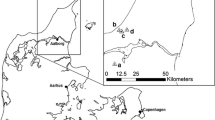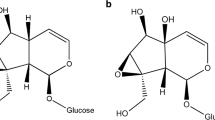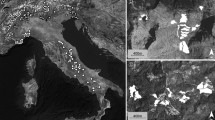Summary
Investigation of larval food plant relationships of populations of Euphydryas editha Boisduval throughout California demonstrated three striking phenomena. First, relationships between butterflies and plants were found to be highly variable among populations utilizing different (but related) food plants. Second, defoliation of food plants was quite common and often extensive; this is contrary to the widely accepted generalization that herbivores rarely defoliate their food plants. Third, larval starvation was the rule, occurring to some extent in most of the populations investigated.
Similar content being viewed by others
References
Andrewartha, H. G., Birch, L. C.: The distribution and abundance of animals. Chicago: Chicago Univ. Press 1954
Breedlove, D. E., Ehrlich, P. R.: Plant-herbivore coevolution: lupines and lycaenids. Science 162, 671–672 (1968)
Breedlove, D. E., Ehrlich, P. R.: Coevolution: patterns of legume predation by a lycaenid butterfly. Oecologia (Berl.) 10, 99–104 (1974)
Clench, H. K.: Temporal dissociation and population regulation in certain hesperiine butterflies. Ecology 48, 1000–1006 (1967)
Dethier, V. G.: Food plant distribution and density and larval dispersal as factors affecting insect populations. Canad. Entomologist 91, 581–596 (1959)
Dolinger, P. M., Ehrlich, P. R., Fitch, W. M., Breedlove, D. E.: Alkaloid and predation patterns in Colorado lupine populations. Oecologia (Berl.) 13, 191–204 (1973)
Ehrlich, P. R.: Intrinsic barriers to disperal in checkerspot butterfly. Science 134, 108–109 (1961)
Ehrlich, P. R.: The population biology of the butterfly, Euphydryas editha. II. The structure of the Jasper Ridge colony. Evolution 19, 327–336 (1965)
Ehrlich, P. R., Birch, L. C.: The “balance of nature” and “population control”. Amer. Naturalist 101, 97–108 (1967)
Ehrlich, P. R., Raven, P. H.: Butterflies and plants: a study in coevolution. Evolution 18, 586–608 (1965)
Gilbert, L. E., Singer, M. C.: Patterns of dispersal and gene flow in a butterfly species. Amer. Naturalist 107, 58–72 (1973)
Labine, P. A.: Population biology of the butterfly, Euphydryas editha. I. Barriers to multiple inseminations. Evolution 18, 335–336 (1964)
Labine, P. A.: The population biology of the butterfly, Euphydryas editha. IV. Sperm precedence. Evolution 20, 580–586 (1966)
Labine, P. A.: The population biology of the butterfly, Euphydryas editha. VIII. Oviposition and its relation to patterns of oviposition in other butterflies. Evolution 22, 799–805 (1968)
Owen, D. F.: Tropical butterflies. Oxford: Clarendon Press 1971
Singer, M. C.: Evolution of food-plant preference in the butterfly, Euphydryas editha. Evolution 25, 383–389 (1971)
Singer, M. C.: Complex components of habitat suitability within a butterfly colony. Science 176, 75–77 (1972)
White, R. R.: Community relationships of the butterfly, Euphydryas editha. Ph. D. dissertation, Stanford University (1973)
Author information
Authors and Affiliations
Rights and permissions
About this article
Cite this article
White, R.R. Food plant defoliation and larval starvation of Euphydryas editha . Oecologia 14, 307–315 (1974). https://doi.org/10.1007/BF00384575
Received:
Issue Date:
DOI: https://doi.org/10.1007/BF00384575




